Parametric Investigation of Oblique Incidence Angle Effects in Near-Fault P Waves on Dynamic Response of Concrete Dam
Abstract
1. Introduction
2. Fundamental Theory of Obliquely Incident P Waves
2.1. Viscous-Spring Artificial Boundary
2.2. Equivalent Forces Input Method for P Waves
2.3. Verification of the Seismic Oblique Incidence Theory
3. Finite Element Model of a Concrete Gravity System
3.1. Constitutive Model of Concrete Damaged Plasticity (CDP)
3.2. Finite Element Model
3.3. Main Material Properties
3.4. Applied Static and Dynamic Loads
4. Seismic Dynamic Response Analysis Under Oblique P Near-Fault Motion with Different Incident Angles
4.1. Seismic Input Conditions of Near-Fault Ground Motion
4.2. Comparison of Damage Behavior Under PL and NP Motion
4.3. Comparison of Displacement Response Under PL and NP Motion
5. Difference Analysis
5.1. Difference Analysis Considering the Effect of Pulse Characteristic
5.2. Difference Analysis Considering the Effect of the Incident Direction
6. Parametric Study
6.1. Discussion on Effects of Seismic Parameters
6.2. Discussion on Coupled Effects of the Pulse Feature and Oblique Incidence
6.3. The Three-Dimensional Prediction Surfaces
7. Conclusions
- (1)
- The numerical results demonstrated that the oblique incidence angle of the P waves significantly influenced the damage to and displacement of the dam. As the incident angle of the P waves increased, the average response also increased, reaching a peak at approximately 60° with a slightly smaller average response at 75°. The damage response value for positive incidence was considerably greater than that for negative oblique incidence. In contrast, the displacement response results exhibited greater symmetry in the positive and negative incidence directions. Moreover, PL motion could cause heightened levels of dynamic response and potential damage compared to NP motion.
- (2)
- The RatioEDP index assessed discrepancies in the response induced by the pulse characteristics. Owing to the upstream and downstream asymmetry of the dam body, the PL ground motion tended to exhibit considerably higher response values under negative oblique incidence. In the presence of strong earthquakes 0.6 g, the variation in the response between the PL and NP ground motions was more pronounced, with the maximum ratio increasing by up to 1.5 times, indicating that strong earthquakes further excite the effect of pulse components on the dam structure.
- (3)
- The influence of the incident direction on the dynamic response was determined using the proposed DiffEDP index. The differences in the damage response caused by positive and negative incidents were nearly identical under NF earthquakes with or without pulse characteristics. Furthermore, the response difference was considerably larger when the PGA was at 0.6 g as opposed to when it was at 0.3 g, with the damage response difference reaching its maximum value at an incident angle of 45°. Regarding displacement response, variations in DiffUc were evident under PL and NP ground motion at 0.6 g, with the maximum value being reached at an incident angle of 15°.
- (4)
- The optimal seismic parameter Sa(T1) was determined by analyzing the effect of the seismic intensity and pulse parameters on the dynamic response. The coupled effects of the pulse characteristics and oblique direction were examined by establishing the relationship between Sa(T1) and the dynamic response at various angles. As the incident angle was varied, the fitting results exhibited variations under different working conditions. The slope and intercept of the fitting line exhibited a quadratic polynomial relationship with the incident angle. In particular, the slope of the fitting line increased steadily with the incident angle, with the growth rate eventually leveling off.
- (5)
- A multivariate nonlinear prediction model was proposed to assess the dynamic response of concrete gravity dams based on the optimal seismic parameter Sa(T1) and incident angle. The 3D prediction surface clearly showed that the response value also increased as the spectral acceleration value increased. The predictive results demonstrated a high level of accuracy compared to the numerical results, allowing for the effective prediction of the seismic demand on concrete gravity dams under arbitrary NF P wave oblique incidence, which is crucial for considering oblique P wave effects in the seismic design and assessment of concrete dams.
Author Contributions
Funding
Institutional Review Board Statement
Informed Consent Statement
Data Availability Statement
Conflicts of Interest
References
- Zhang, S.; Wang, G. Effects of near-fault and far-fault ground motions on nonlinear dynamic response and seismic damage of concrete gravity dams. Soil Dyn. Earthq. Eng. 2013, 53, 217–229. [Google Scholar] [CrossRef]
- Sun, B.; Zhang, S.; Deng, M.; Wang, C. Inelastic dynamic response and fragility analysis of arched hydraulic tunnels under as-recorded far-fault and near-fault ground motions. Soil Dyn. Earthq. Eng. 2020, 132, 106070. [Google Scholar] [CrossRef]
- Hu, Y.; Jiang, L.; Ye, J.; Zhang, X.; Jiang, L. Seismic responses and damage assessment of a mid-rise cold-formed steel building under far-fault and near-fault ground motions. Thin-Walled Struct. 2021, 163, 107690. [Google Scholar] [CrossRef]
- Xu, S.; Liu, J.; Yin, X.; Xu, Q. Seismic performance analysis of concrete dams considering the coupled effects of wavelet asymmetry and incident direction under near-fault ground motions. Eng. Struct. 2025, 327, 119670. [Google Scholar] [CrossRef]
- Gorai, S.; Maity, D. Seismic fragility assessment of concrete gravity dams under near source synthetic ground motions. Struct. Infrastruct. Eng. 2023, 21, 281–301. [Google Scholar] [CrossRef]
- Bigdeli, A.; Akbari, H.; Alembagheri, M.; Haghgou, H.; Matinfar, M. Influence of near-field ground motions and their equivalent pulses on nonlinear seismic response of intake-outlet towers and predicting based on artificial neural networks. Structures 2023, 52, 1051–1070. [Google Scholar] [CrossRef]
- Zhai, Y.; Zhang, L.; Cui, B.; Zhang, H.; Ma, T. Evolution criteria of overall damage of concrete gravity dam body and foundation under near-fault ground motion. Structures 2022, 43, 594–605. [Google Scholar] [CrossRef]
- Gorai, S.; Maity, D. Numerical investigation on seismic behaviour of aged concrete gravity dams to near source and far source ground motions. Nat. Hazards 2021, 105, 943–966. [Google Scholar] [CrossRef]
- Aghamolaei, M.; Azizkandi, A.S.; Baziar, M.H.; Ghavami, S. Performance-based analysis of cantilever retaining walls subjected to near-fault ground shakings. Comput. Geotech. 2021, 130, 103924. [Google Scholar] [CrossRef]
- Sun, B.; Deng, M.; Zhang, S.; Wang, C.; Cui, W.; Du, M.; Lai, Y. The effect of near-fault earthquakes and wavelet-generated artificial near-fault earthquakes on the seismic behavior of rockfill dams. Structures 2023, 58, 105342. [Google Scholar] [CrossRef]
- Wu, Q.; Li, D.-Q.; Liu, Y.; Du, W. Seismic performance of earth dams founded on liquefiable soil layer subjected to near-fault pulse-like ground motions. Soil Dyn. Earthq. Eng. 2021, 143, 106623. [Google Scholar] [CrossRef]
- Daei, A.; Poursha, M.; Zarrin, M. Seismic performance evaluation of code-compliant RC moment-resisting frame buildings subjected to near-fault pulse-like and non-pulse-like ground motions. J. Earthq. Eng. 2022, 26, 5058–5085. [Google Scholar] [CrossRef]
- Loh, C.H.; Wan, S.; Liao, W.I. Effects of hysteretic model on seismic demands: Consideration of near-fault ground motions. Struct. Des. Tall Build. 2002, 11, 155–169. [Google Scholar] [CrossRef]
- Mavroeidis, G.P.; Dong, G.; Papageorgiou, A.S. Near-fault ground motions, and the response of elastic and inelastic single-degree-of-freedom (SDOF) systems. Earthq. Eng. Struct. Dyn. 2004, 33, 1023–1049. [Google Scholar] [CrossRef]
- Zou, D.; Han, H.; Liu, J.; Yang, D.; Kong, X. Seismic failure analysis for a high concrete face rockfill dam subjected to near-fault pulse-like ground motions. Soil Dyn. Earthq. Eng. 2017, 98, 235–243. [Google Scholar] [CrossRef]
- Li, L.-X.; Li, C.; Hao, H. Seismic performance of post-tensioned self-centering concrete frames under near-fault pulse-like ground motions. Eng. Struct. 2023, 277, 115480. [Google Scholar] [CrossRef]
- Xu, Q.; Xu, S.; Chen, J.; Li, J. Dimensionless analysis of pulse-like effects on the seismic behavior of a dam based on wavelet-decomposed near-fault ground motions. Structures 2021, 33, 2003–2018. [Google Scholar] [CrossRef]
- Yazdani, Y.; Alembagheri, M. Nonlinear seismic response of a gravity dam under near-fault ground motions and equivalent pulses. Soil Dyn. Earthq. Eng. 2017, 92, 621–632. [Google Scholar] [CrossRef]
- Mashhadi, S.; Homaei, F.; Asadi, A.; Tajammolian, H. Fragility analysis of steel MRFs: Effects of frequency-content components of near-fault pulse-like ground motions and setbacks. Structures 2021, 33, 3655–3666. [Google Scholar] [CrossRef]
- Sun, B.; Deng, M.; Zhang, S.; Cui, W.; Wang, C.; Yu, L.; Cao, K. Inelastic dynamic analysis and damage assessment of a hydraulic arched tunnel under near-fault SV waves with arbitrary incoming angles. Tunnel. Undergr. Space Technol. 2020, 104, 103523. [Google Scholar] [CrossRef]
- Chen, D.; Pan, Z.; Zhao, Y. Seismic damage characteristics of high arch dams under oblique incidence of SV waves. Eng. Fail. Anal. 2023, 152, 107445. [Google Scholar] [CrossRef]
- Li, C.; Song, Z.; Wang, F.; Liu, Y. Analysis of the seismic response and failure evaluation of the slabs of asphalt concrete-faced rockfill dams under SV-Waves with arbitrary angles. Comput. Geotech. 2024, 168, 106125. [Google Scholar] [CrossRef]
- Zhang, T.; Xu, Q.; Chen, J.; Wang, Y.; Li, J. Analysis framework for the seismic performance of a concrete high-arch dam considering the incident direction and oblique incident angle of near-fault SV-waves. Soil Dyn. Earthq. Eng. 2023, 173, 108119. [Google Scholar] [CrossRef]
- Zhang, J.; Li, M.; Han, S. Seismic analysis of gravity dam–layered foundation system subjected to earthquakes with arbitrary incident angles. Int. J. Geomech. 2022, 22, 04021279. [Google Scholar] [CrossRef]
- Wang, X.; Chen, J.; Xiao, M. Seismic responses of an underground powerhouse structure subjected to oblique incidence SV and P waves. Soil Dyn. Earthq. Eng. 2019, 119, 130–143. [Google Scholar] [CrossRef]
- Bi, Z.; Zhang, L.; He, X.; Zhai, Y. Effect of oblique incidence angle and frequency content of P and SV waves on the dynamic behavior of liquid tanks. Soil Dyn. Earthq. Eng. 2023, 171, 107929. [Google Scholar] [CrossRef]
- Xu, S.; Xu, Q.; Chen, J.; Li, J. Seismic performance analysis of gravity dam system under arbitrary oblique incidence of near-fault SV ground motions. Int. J. Geomech. 2022, 22, 04022240. [Google Scholar] [CrossRef]
- Sun, B.; Zhang, S.; Cui, W.; Deng, M.; Wang, C. Nonlinear dynamic response and damage analysis of hydraulic arched tunnels subjected to P waves with arbitrary incoming angles. Comput. Geotech. 2020, 118, 103358. [Google Scholar] [CrossRef]
- Zhu, J.; Li, X.; Liang, J.; Kontoe, S.; He, Q.; Chen, S. Effects of pulse-like ground motions on tunnels in saturated poroelastic soil for obliquely incident seismic waves. Soil Dyn. Earthq. Eng. 2023, 173, 108100. [Google Scholar] [CrossRef]
- Song, Z.; Wang, F.; Li, Y.; Liu, Y. Nonlinear seismic responses of the powerhouse of a hydropower station under near-fault plane P-wave oblique incidence. Eng. Struct. 2019, 199, 109613. [Google Scholar] [CrossRef]
- Wang, M.; Chi, S. Dynamic response analysis of high earth-rockfill dam subjected to P wave with arbitrary incoming angles. Soil Dyn. Earthq. Eng. 2022, 157, 107260. [Google Scholar] [CrossRef]
- Liu, J.B.; Du, Y.X.; Du, X.L.; Wang, Z.Y.; Wu, J. 3D viscous-spring artificial boundary in time domain. Earthq. Eng. Struct. Dyn. 2006, 5, 93–102. [Google Scholar] [CrossRef]
- Pan, J. Seismic damage behavior of gravity dams under the effect of concrete inhomogeneity. J. Earthq. Eng. 2021, 25, 1438–1458. [Google Scholar] [CrossRef]
- Chen, D.; Hou, C.; Wang, F. Influences on the seismic response of the gravity dam-foundation-reservoir system with different boundary and input models. Shock Vibrat. 2021, 2021, 6660145. [Google Scholar] [CrossRef]
- Wang, J.T.; Zhang, M.X.; Jin, A.Y.; Zhang, C.H. Seismic fragility of arch dams based on damage analysis. Soil Dyn. Earthq. Eng. 2018, 109, 58–68. [Google Scholar] [CrossRef]
- Huang, J.Q.; Du, X.L.; Jin, L.; Zhao, M. Impact of incident angles of P waves on the dynamic responses of long lined tunnels. Earthq. Eng. Struct. Dyn. 2016, 45, 2435–2454. [Google Scholar] [CrossRef]
- Xu, S.; Xu, Q.; Chen, J.; Li, J. Improved endurance time analysis for seismic responses of concrete dam under near-fault pulse-like ground motions. Eng. Struct. 2022, 270, 114912. [Google Scholar] [CrossRef]
- Lee, J.; Fenves, G.L. Plastic-damage model for cyclic loading of concrete structures. J. Eng. Mech. 1998, 124, 892–900. [Google Scholar] [CrossRef]
- Lee, J.; Fenves, G.L. A plastic-damage concrete model for earthquake analysis of dams. Earthq. Eng. Struct. Dyn. 1998, 27, 937–956. [Google Scholar] [CrossRef]
- Wang, J.; Jin, A.; Du, X.; Wu, M. Scatter of dynamic response and damage of an arch dam subjected to artificial earthquake accelerograms. Soil Dyn. Earthq. Eng. 2016, 87, 93–100. [Google Scholar] [CrossRef]
- Calayir, Y.; Karaton, M. A continuum damage concrete model for earthquake analysis of concrete gravity dam-reservoir systems. Soil Dyn. Earthq. Eng. 2005, 25, 857–869. [Google Scholar] [CrossRef]
- Alembagheri, M.; Ghaemian, M. Damage assessment of a concrete arch dam through nonlinear incremental dynamic analysis. Soil Dyn. Earthq. Eng. 2013, 44, 127–137. [Google Scholar] [CrossRef]
- Wang, G.; Wang, Y.; Lu, W.; Yan, P.; Chen, M. Earthquake direction effects on seismic performance of concrete gravity dams to mainshock–aftershock sequences. J. Earthq. Eng. 2018, 24, 1134–1155. [Google Scholar] [CrossRef]
- Hariri-Ardebili, M.A.; Seyedkolbadi, S.M.; Kianoush, M.R. FEM-based parametric analysis of a typical gravity dam considering input excitation mechanism. Soil Dyn. Earthq. Eng. 2016, 84, 22–43. [Google Scholar] [CrossRef]
- Yazdani, Y.; Alembagheri, M. Seismic vulnerability of gravity dams in near-fault areas. Soil Dyn. Earthq. Eng. 2017, 102, 15–24. [Google Scholar] [CrossRef]
- Wang, G.; Wang, Y.; Lu, W.; Yan, P.; Zhou, W.; Chen, M. A general definition of integrated strong motion duration and its effect on seismic demands of concrete gravity dams. Eng. Struct. 2016, 125, 481–493. [Google Scholar] [CrossRef]
- Zhou, C.-G.; Zou, D.-G.; Yu, X. Influence of seismic wave type and incident direction on the dynamic response of tall concrete-faced rockfill dams. Earthq. Sci. 2022, 35, 343–354. [Google Scholar] [CrossRef]
- Mavroeidis, G.P.; Papageorgiou, A.S. A mathematical representation of near-fault ground motions. Bull. Seismol. Soc. Amer. 2003, 93, 1099–1131. [Google Scholar] [CrossRef]
- Bray, J.D.; Rodriguezmarek, A. Characterization of forward-directivity ground motions in the near-fault region. Soil Dyn. Earthq. Eng. 2004, 24, 815–828. [Google Scholar] [CrossRef]
- PEER. Pacific Earthquake Engineering Research Center, PEER Strong Motion Database; University of California: Berkeley, CA, USA. Available online: http://ngawest2.berkeley.edu (accessed on 15 June 2025).
- Shahi, S.K.; Baker, J.W. An efficient algorithm to identify strong-velocity pulses in multicomponent ground motions. Bull. Seismol. Soc. Amer. 2014, 104, 2456–2466. [Google Scholar] [CrossRef]
- Baker, J.W. Quantitative classification of near-fault ground motions using wavelet analysis. Bull. Seismol. Soc. Am. 2007, 97, 1486–1501. [Google Scholar] [CrossRef]
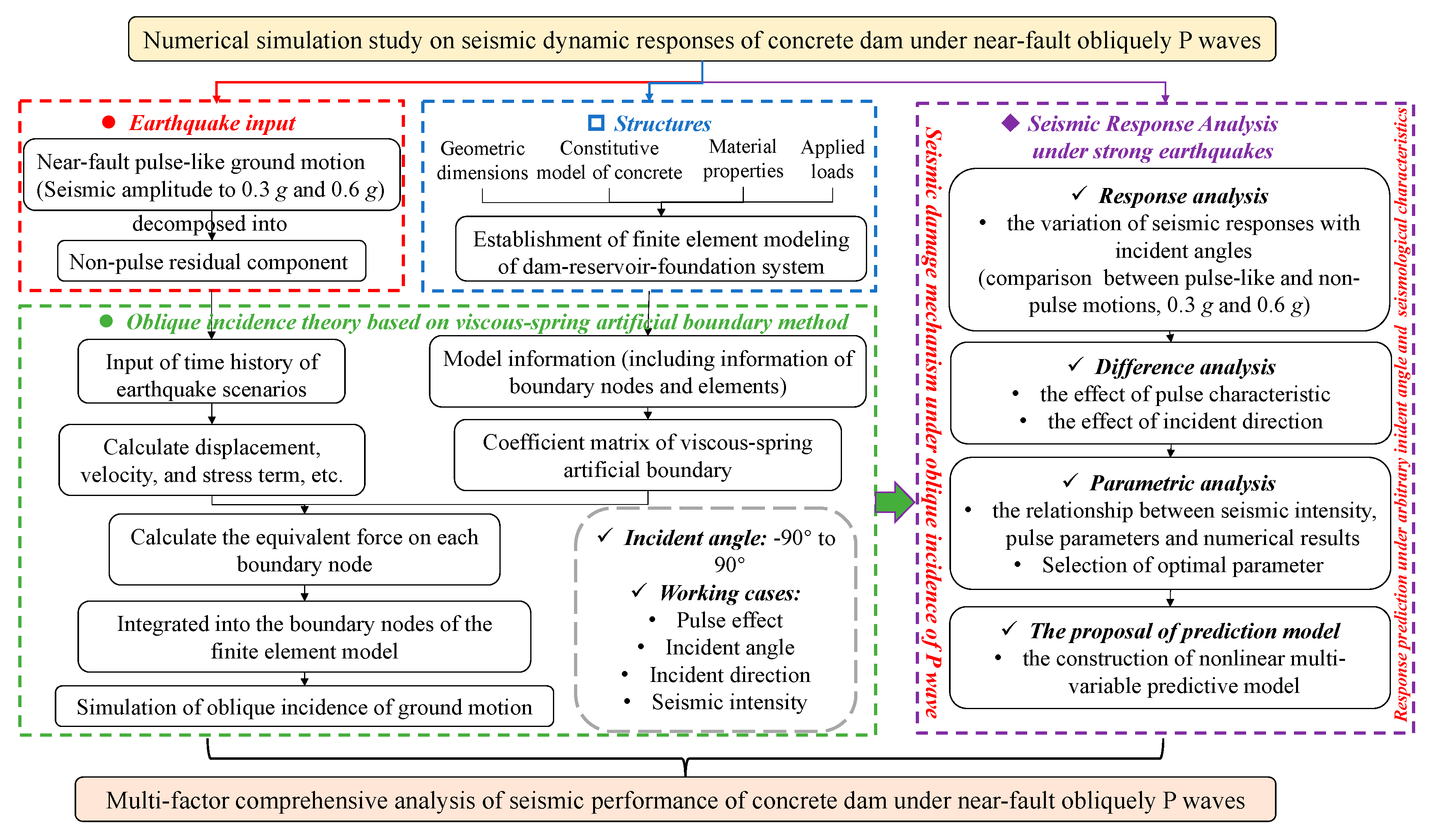
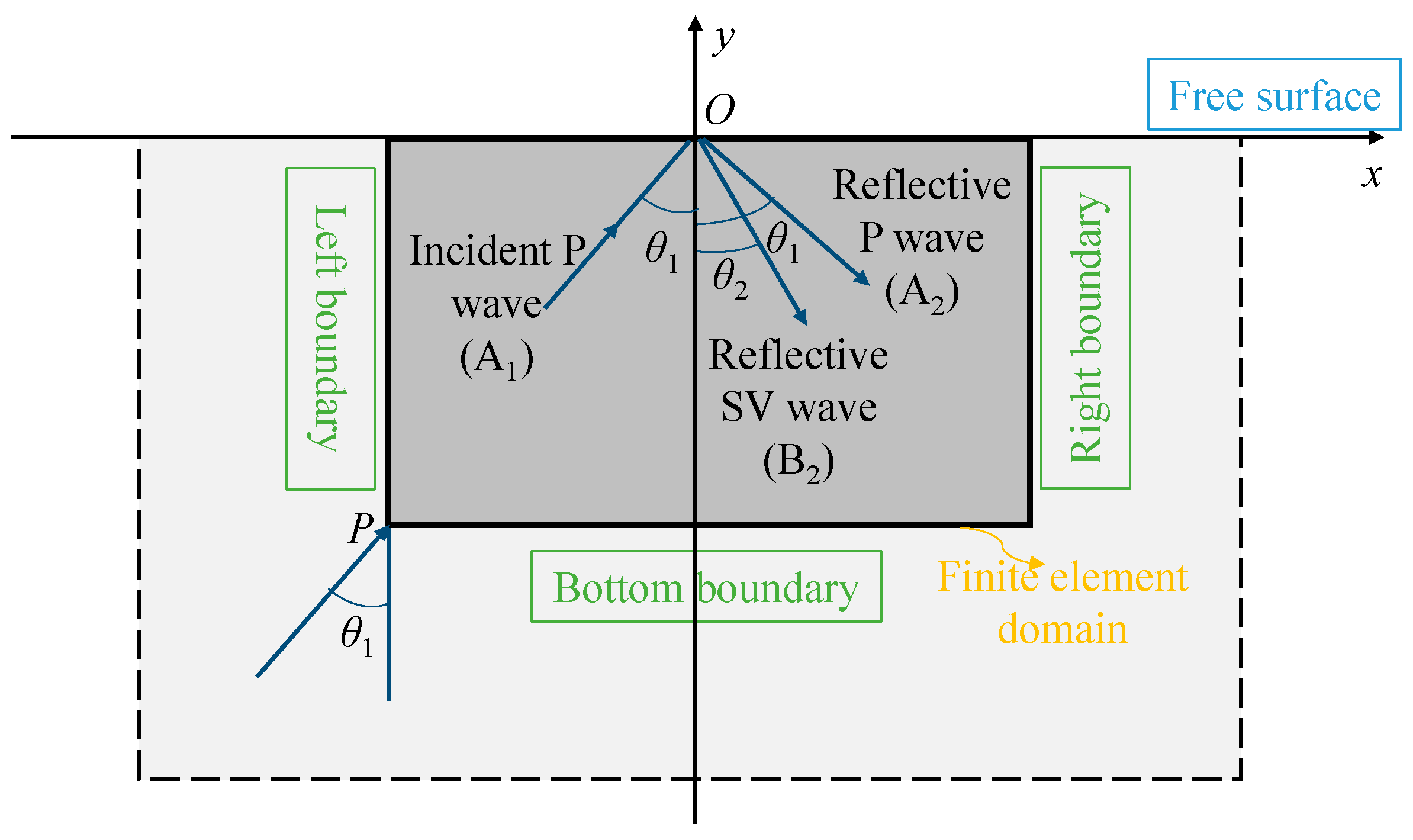
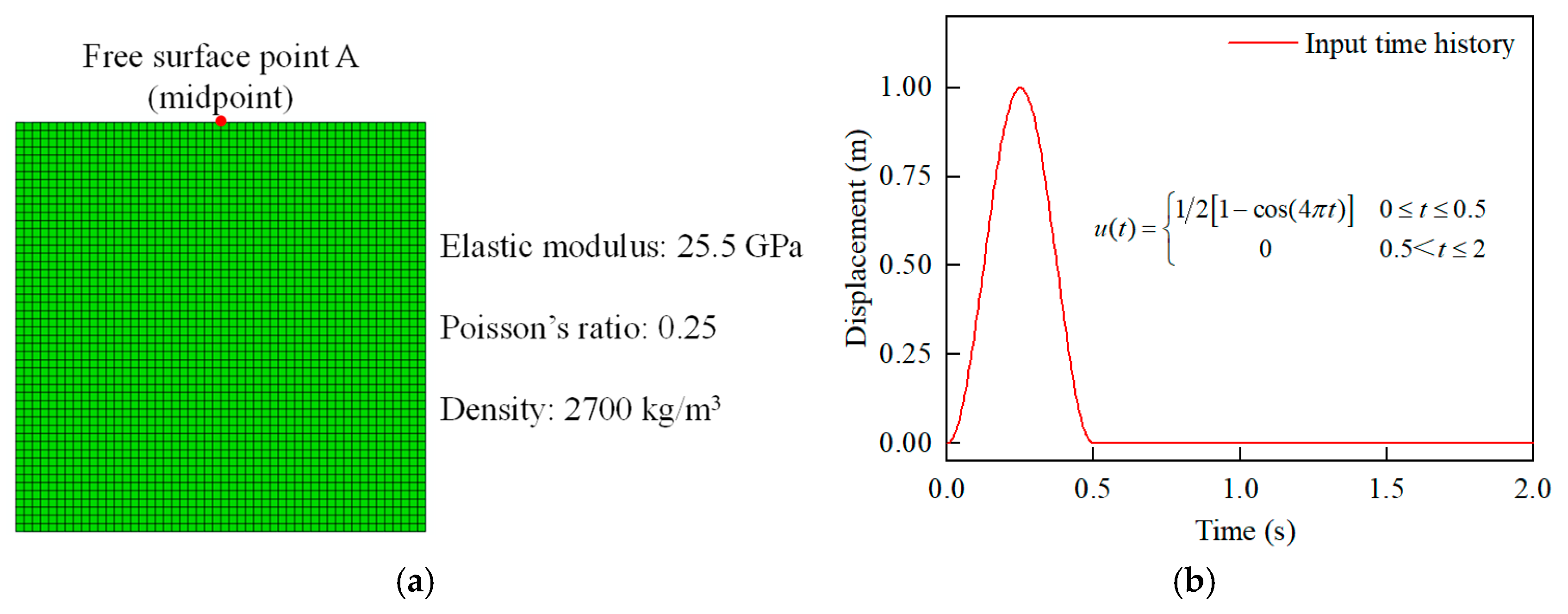

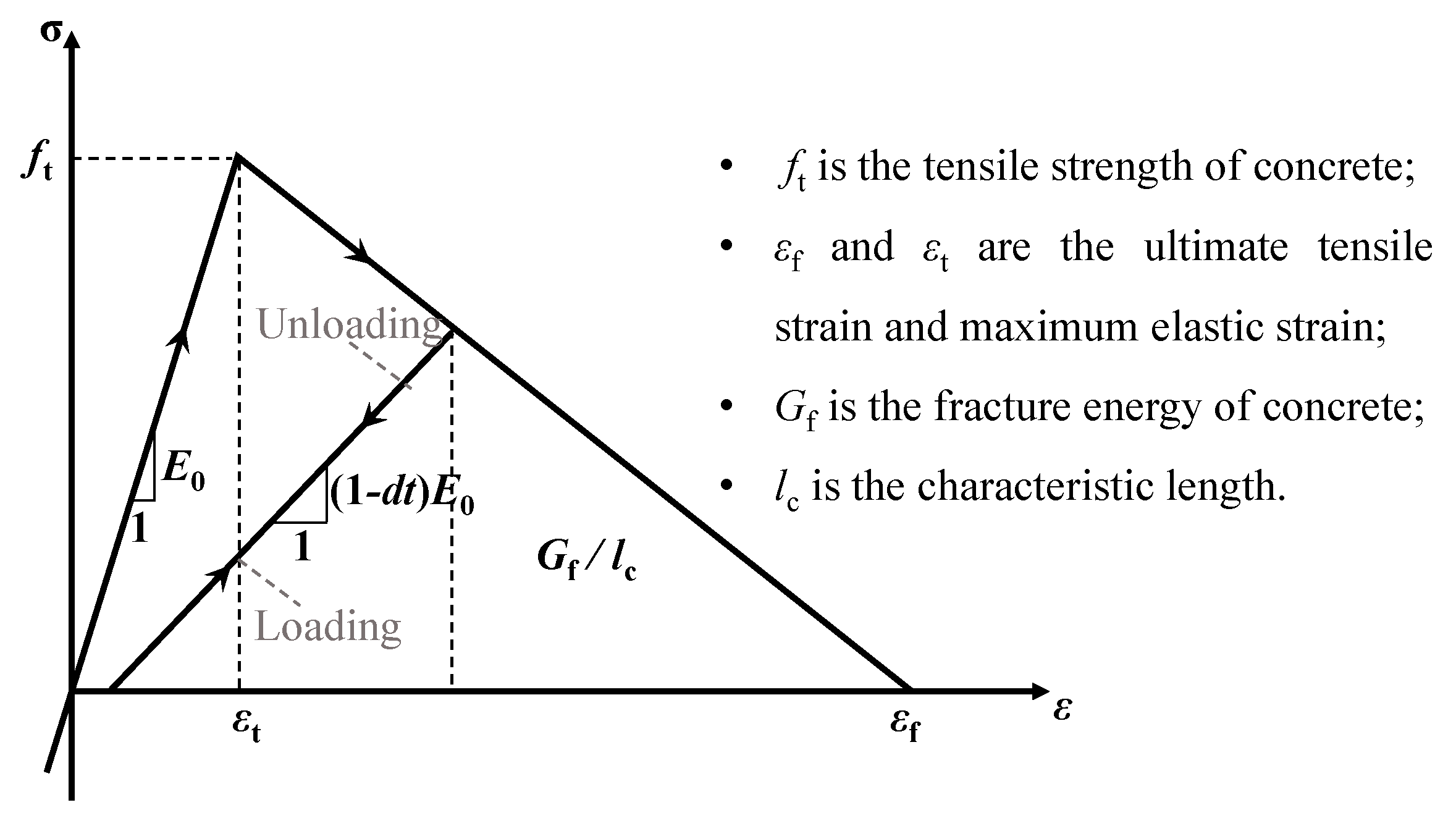
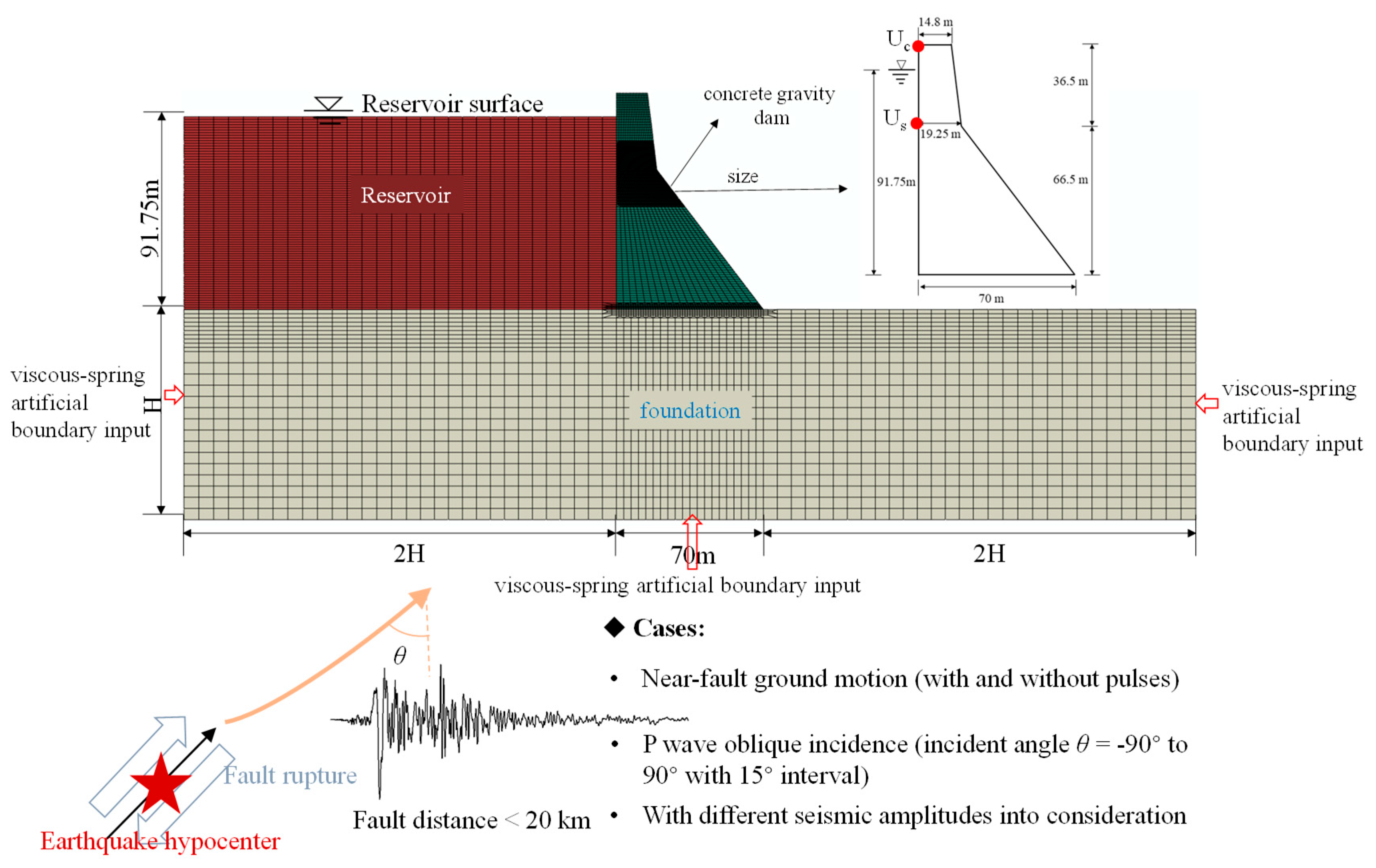
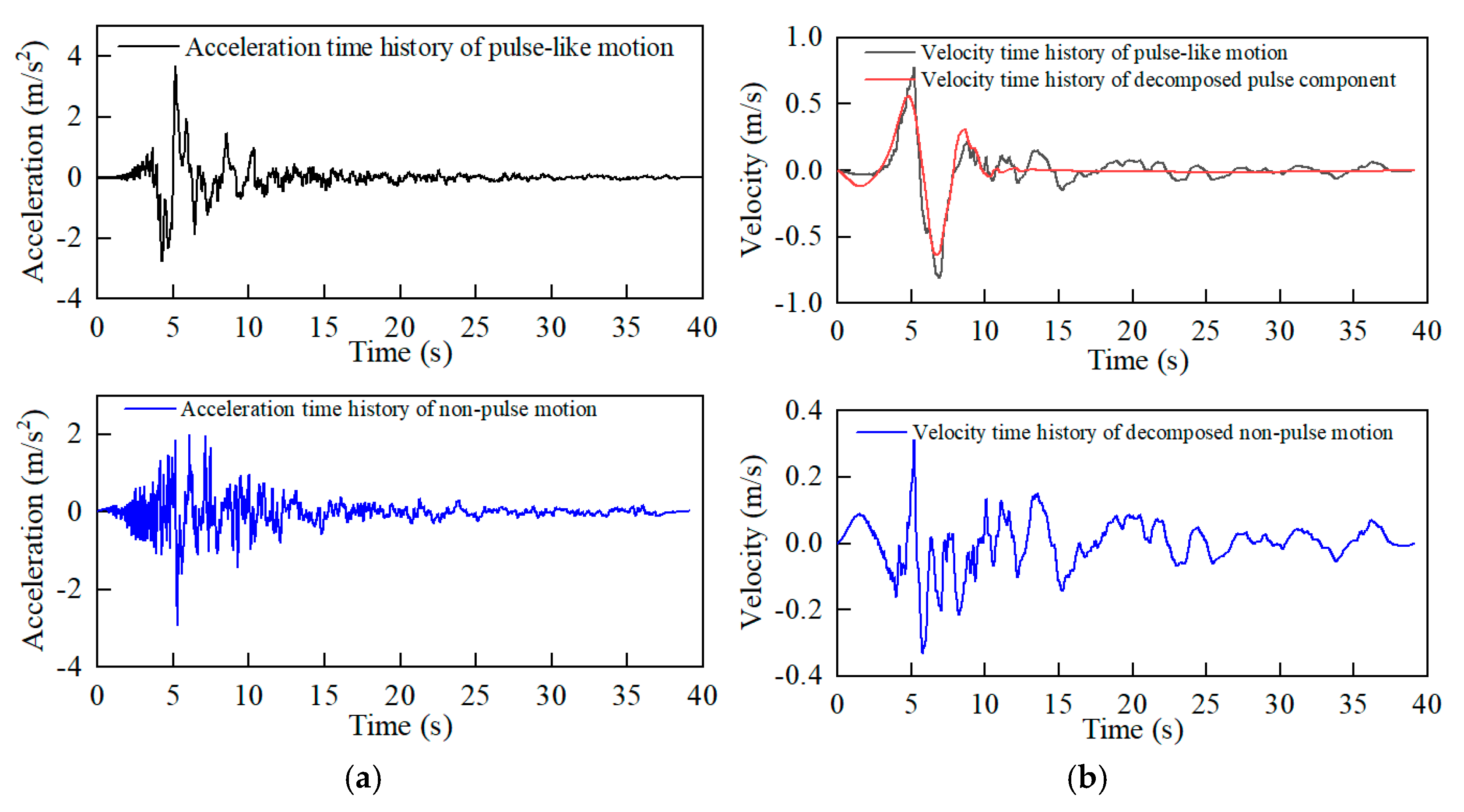
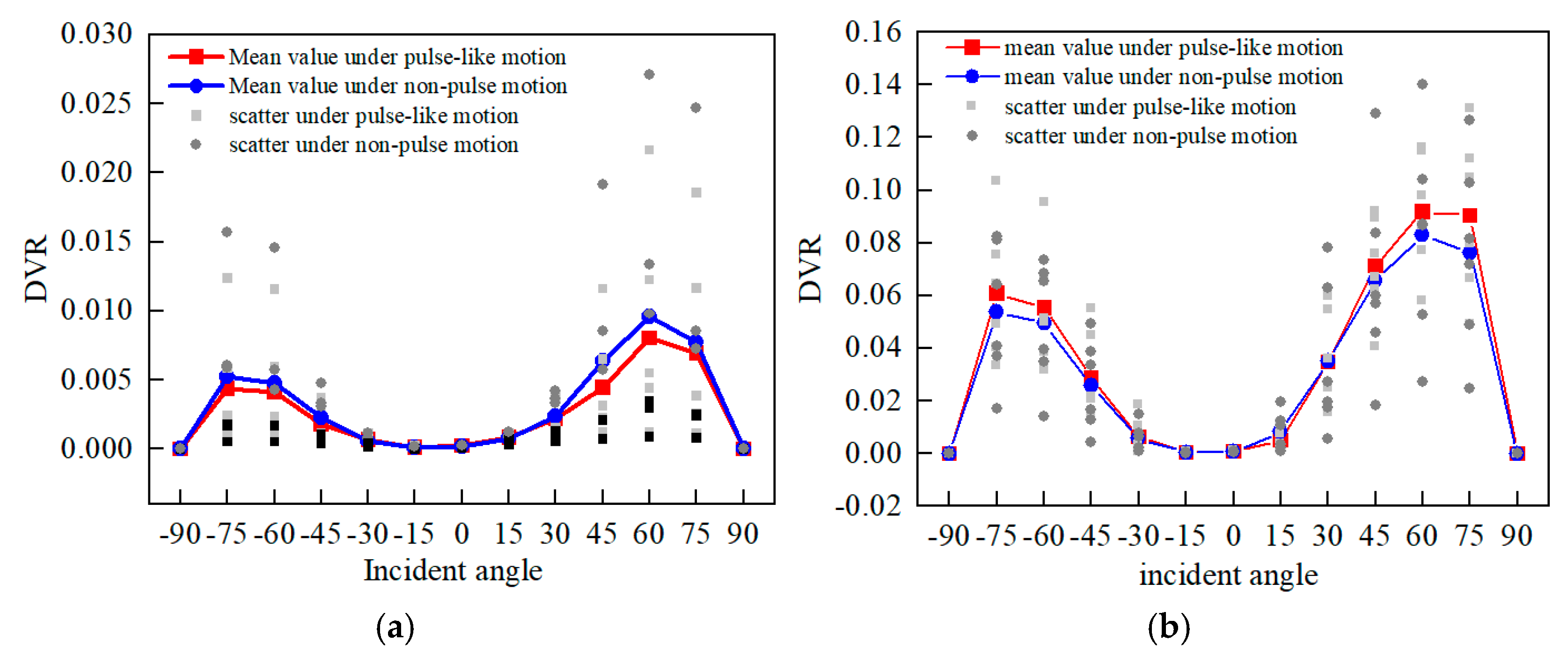

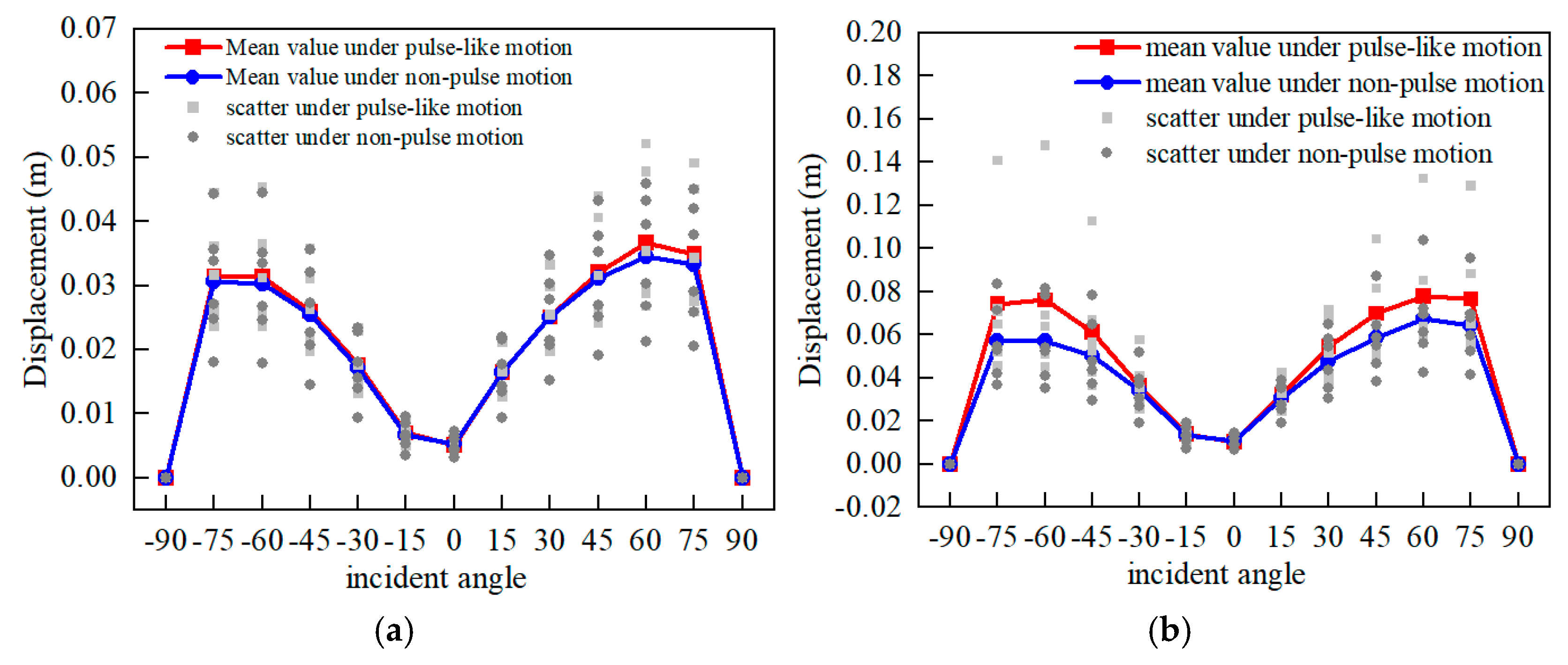
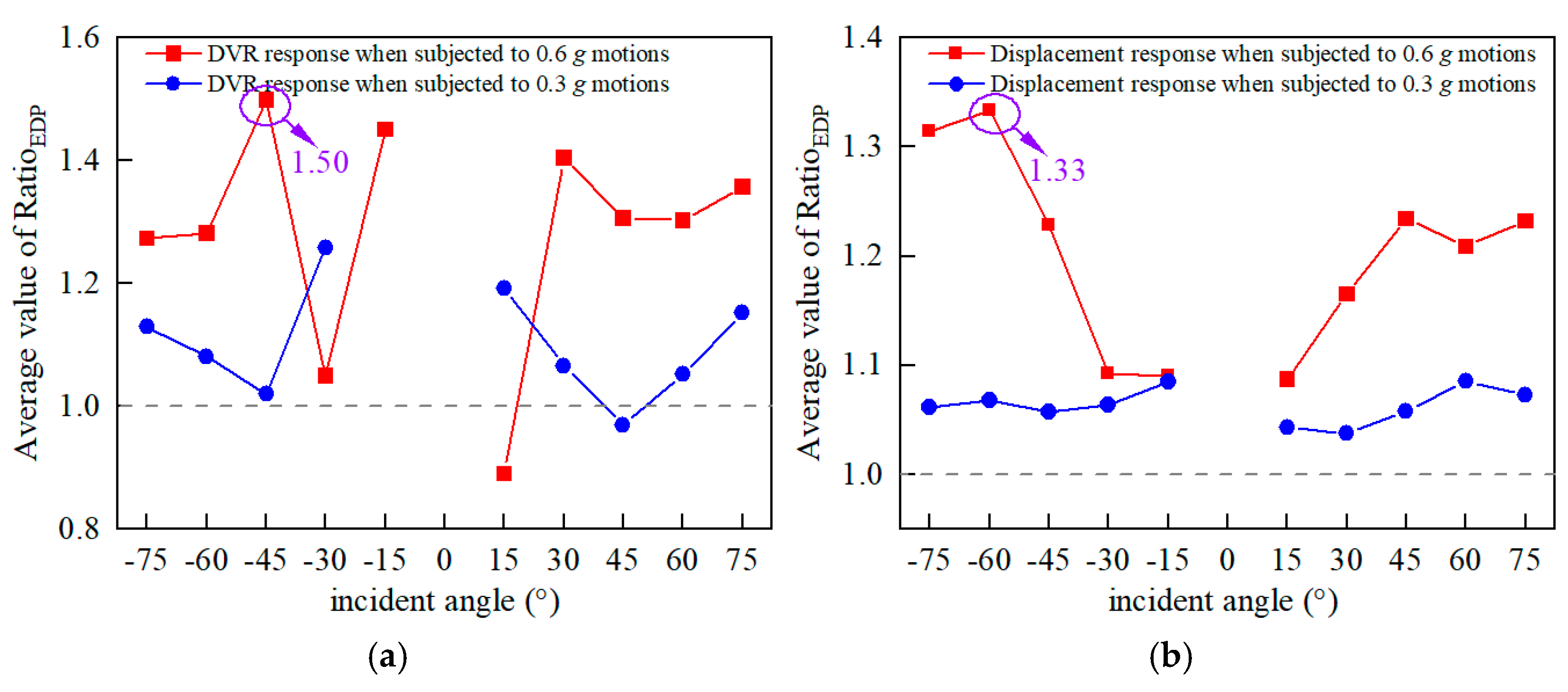
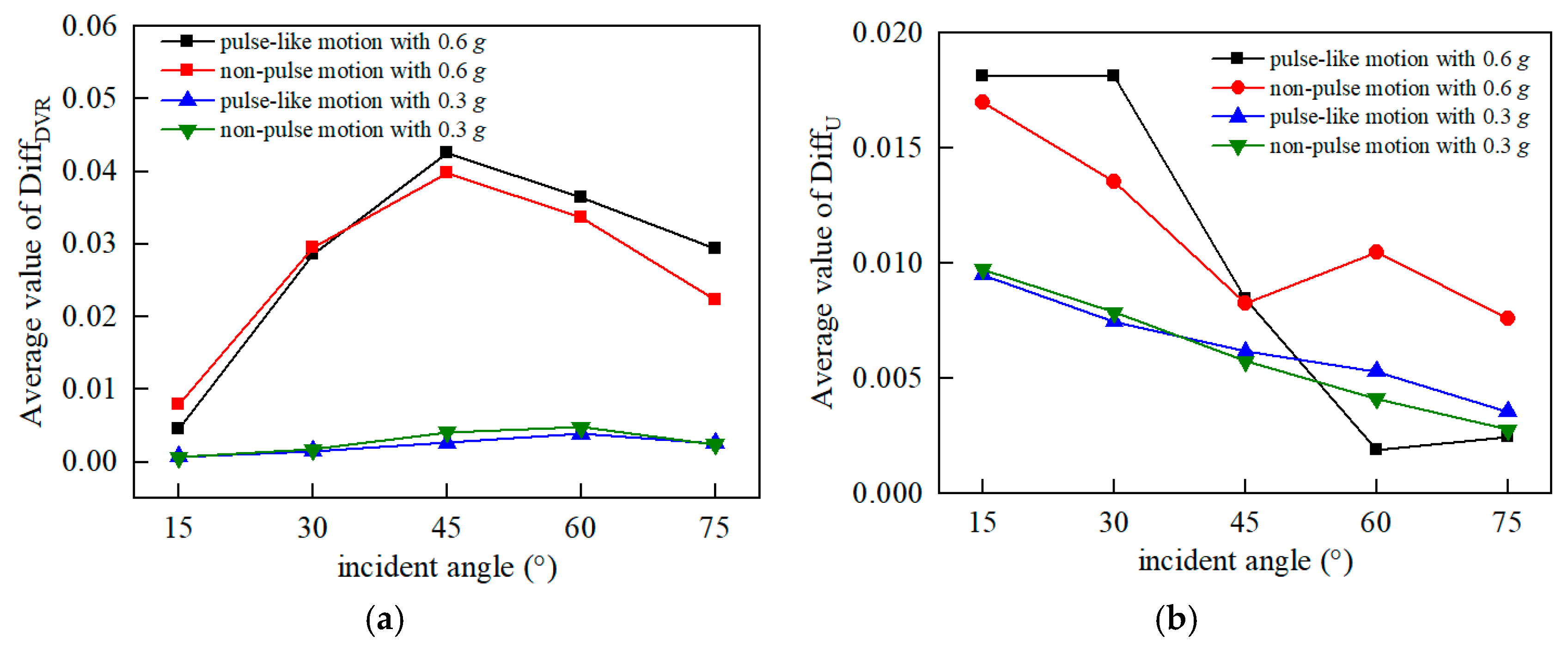
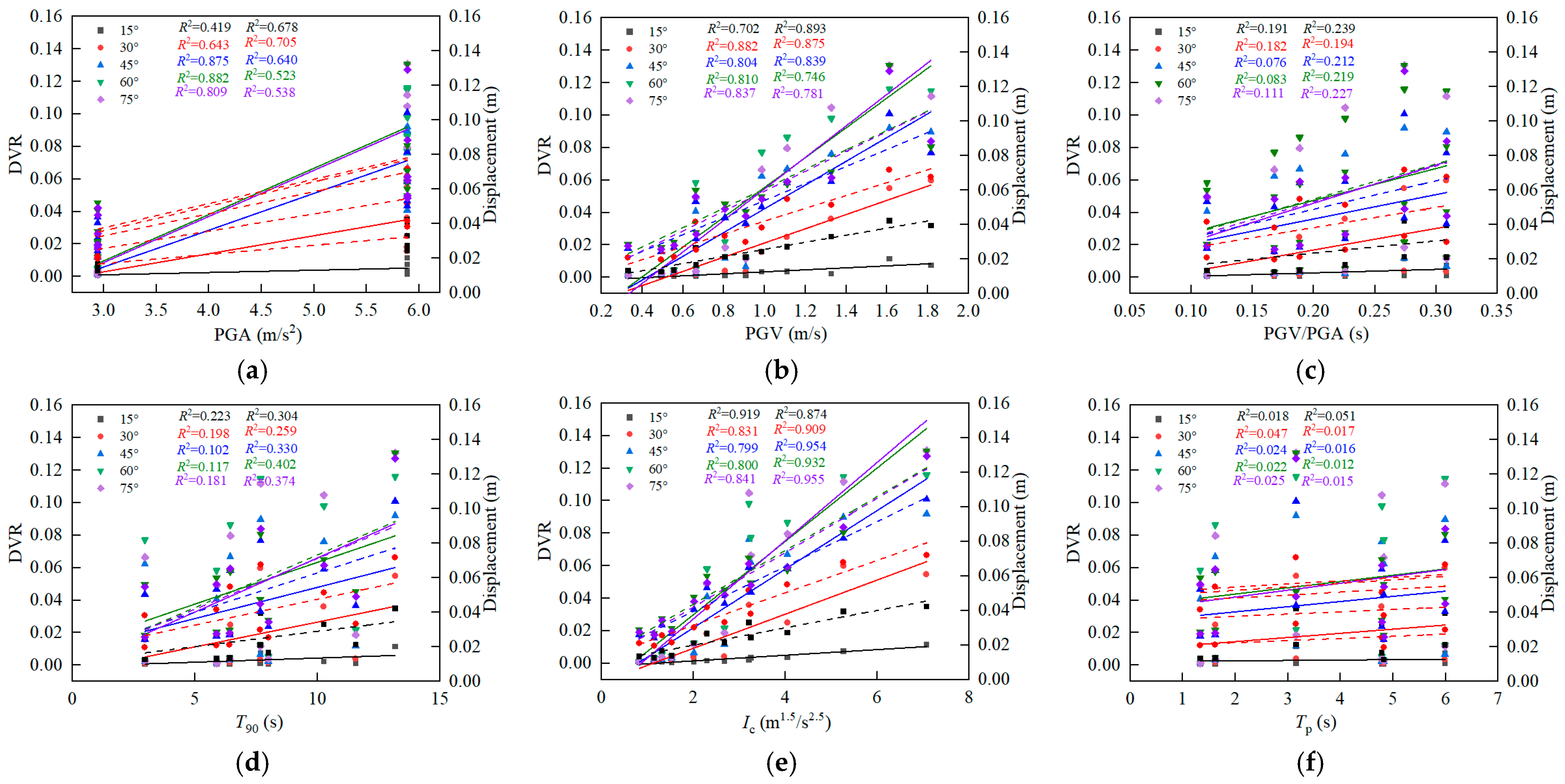
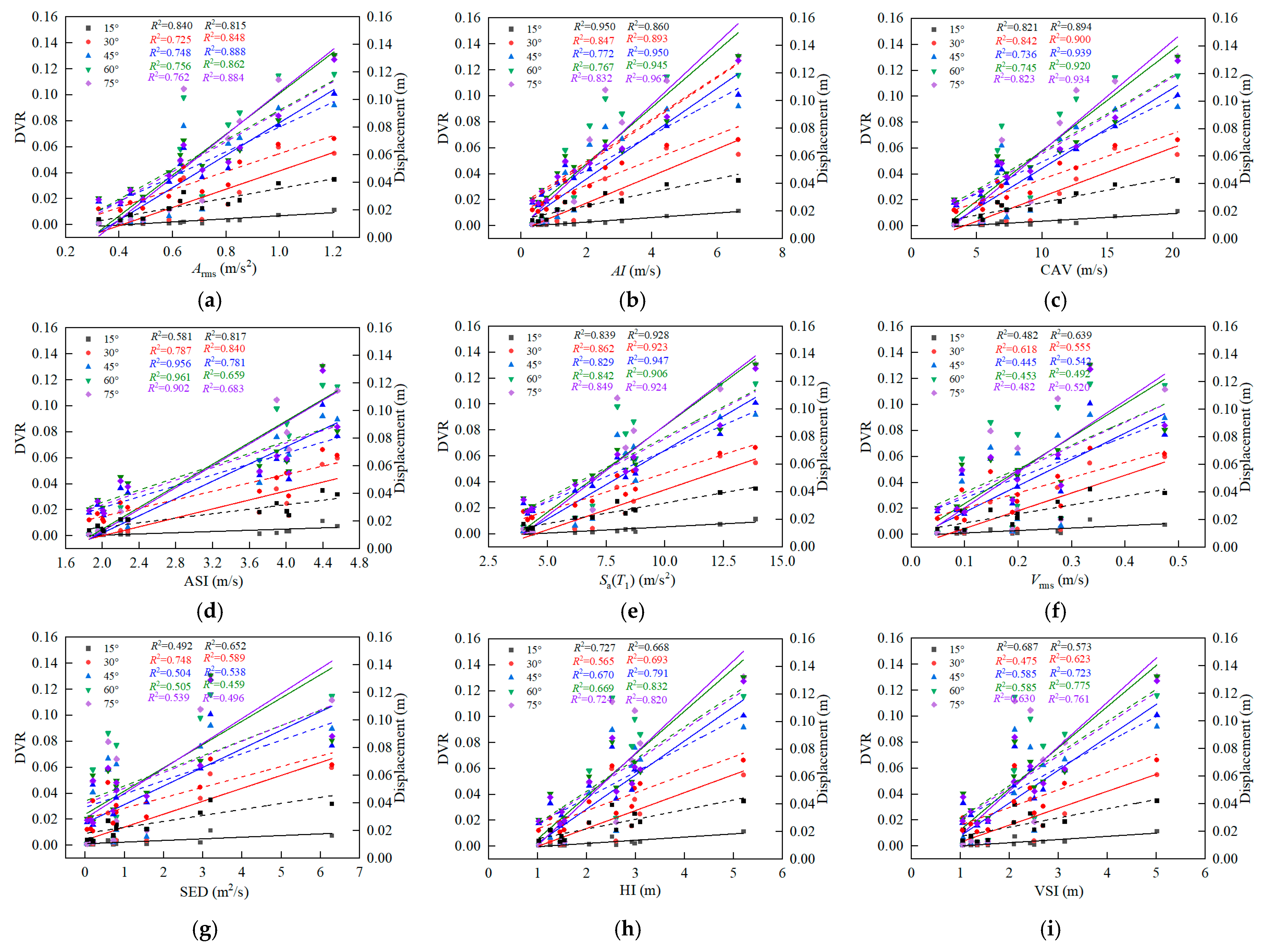
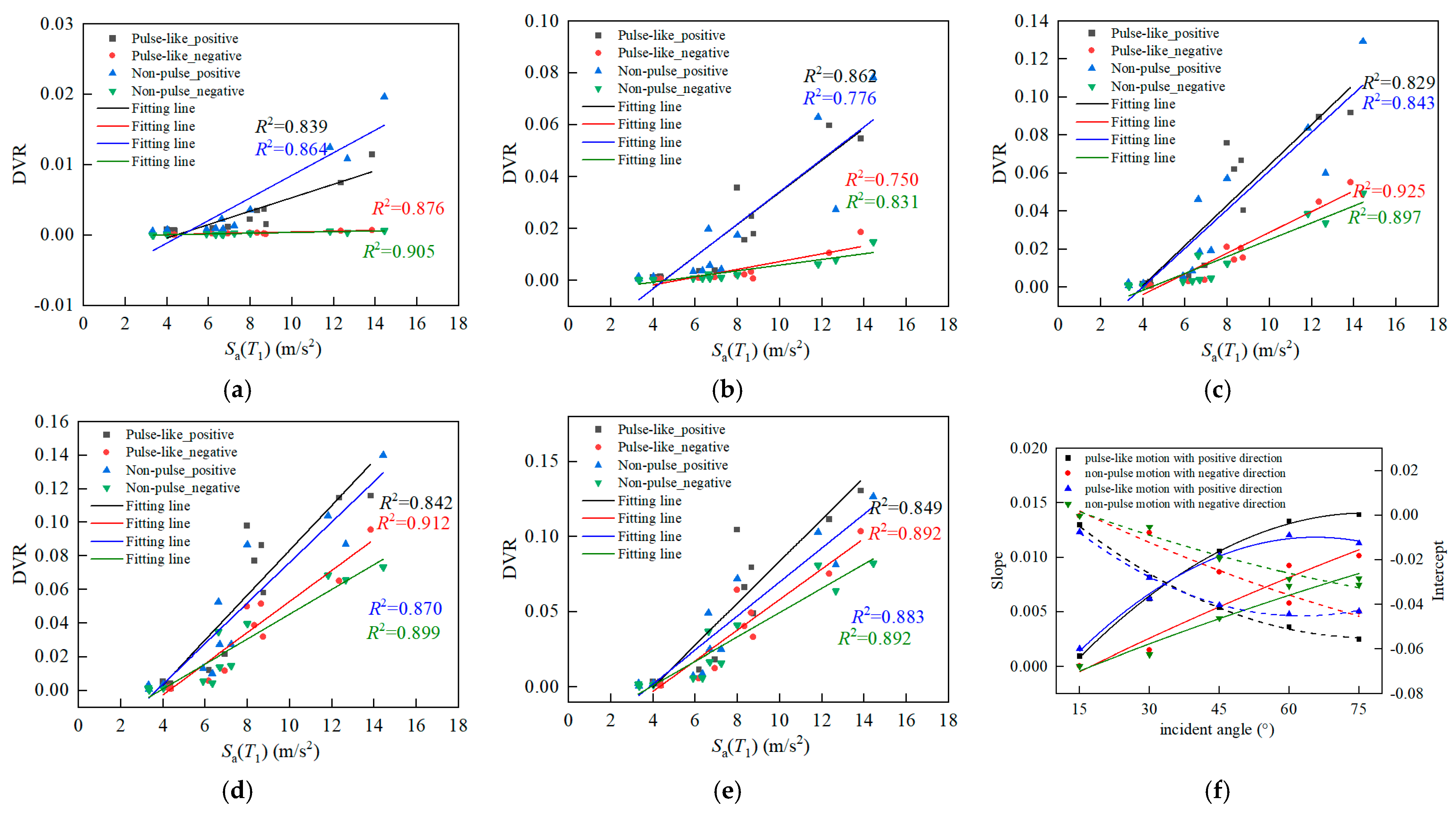
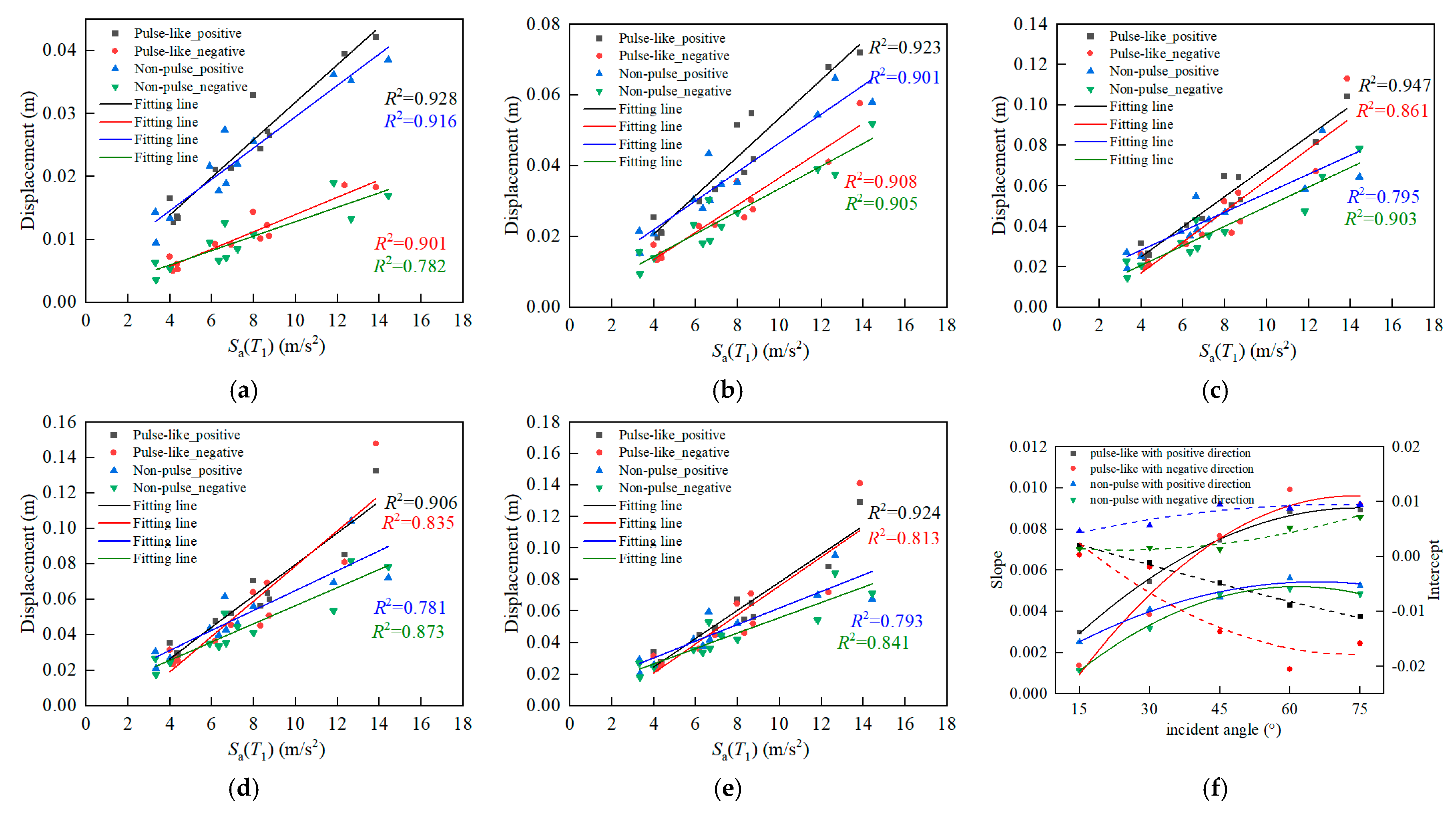
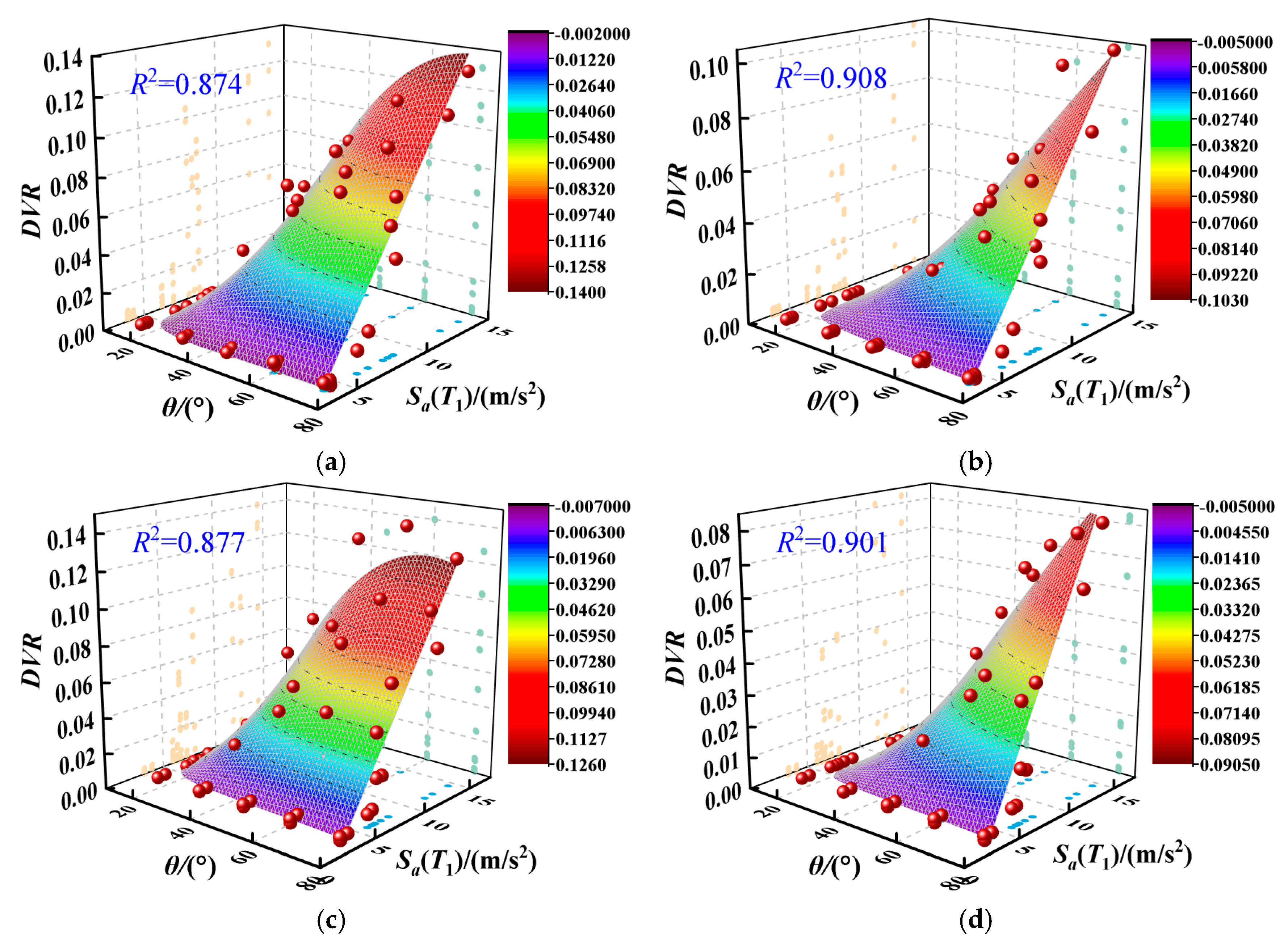
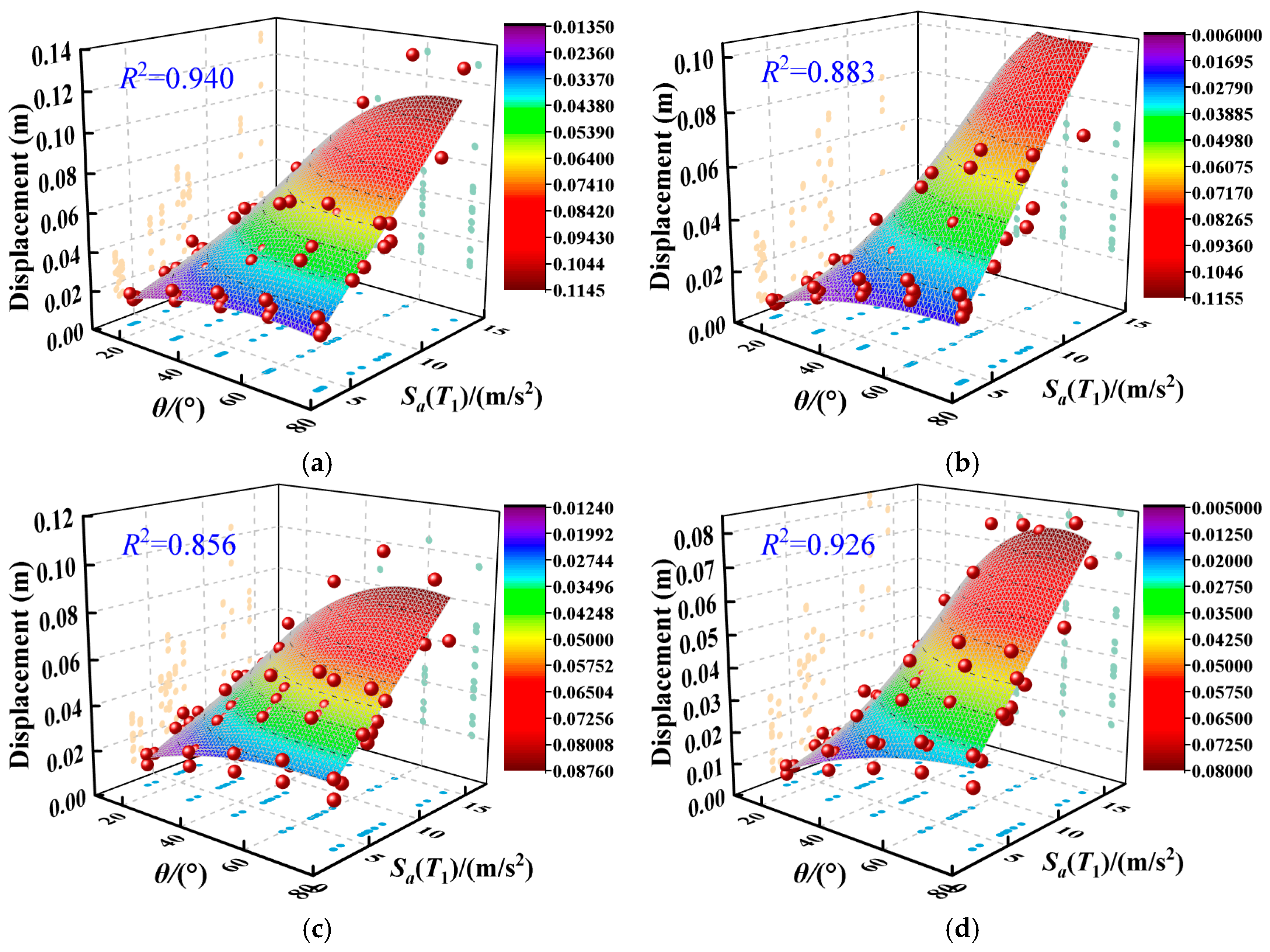
| Material Parameters | Elastic Modulus (GPa) | Bulk Modulus (GPa) | Density (kg/m3) | Poisson’s Ratio |
|---|---|---|---|---|
| Concrete | 31 | - | 2643 | 0.2 |
| Foundation rock | 21.6 | - | 2000 | 0.2 |
| Reservoir water | - | 2.07 | 1000 | - |
| 5 | DVR Response | Displacement Response | ||||||||||
|---|---|---|---|---|---|---|---|---|---|---|---|---|
| Coefficients | a | b | c | d | e | f | a | b | c | d | e | f |
| PL (+) | −3.46 × 10−6 | 5.32 × 10−4 | −0.0064 | 1.30 × 10−5 | −0.002 | 0.022 | −1.71 × 10−6 | 2.56 × 10−4 | −5.50 × 10−4 | 5.49 × 10−7 | −2.74 × 10−4 | 0.00619 |
| PL (−) | −3.74 × 10−7 | 2.20 × 10−4 | −0.00369 | 3.50 × 10−6 | −0.0011 | 0.0177 | −2.54 × 10−6 | 3.73 × 10−4 | −0.0041 | 5.92 × 10−6 | −8.71 × 10−4 | 0.0142 |
| NP (+) | −4.07 × 10−6 | 5.34 × 10−4 | −0.00569 | 1.65 × 10−5 | −0.0021 | 0.0195 | −1.14 × 10−6 | 1.50 × 10−4 | 5.12 × 10−4 | −1.72 × 10−6 | 2.40 × 10−4 | 0.00107 |
| NP (−) | −3.47 × 10−7 | 1.80 × 10−4 | −0.00304 | 2.95 × 10−6 | −8.35 × 10−4 | 0.0134 | −1.90 × 10−6 | 2.34 × 10−4 | −0.0020 | 2.43 × 10−6 | −1.15 × 10−4 | 0.00254 |
Disclaimer/Publisher’s Note: The statements, opinions and data contained in all publications are solely those of the individual author(s) and contributor(s) and not of MDPI and/or the editor(s). MDPI and/or the editor(s) disclaim responsibility for any injury to people or property resulting from any ideas, methods, instructions or products referred to in the content. |
© 2025 by the authors. Licensee MDPI, Basel, Switzerland. This article is an open access article distributed under the terms and conditions of the Creative Commons Attribution (CC BY) license (https://creativecommons.org/licenses/by/4.0/).
Share and Cite
Xu, S.; Liu, J.; Xu, Q. Parametric Investigation of Oblique Incidence Angle Effects in Near-Fault P Waves on Dynamic Response of Concrete Dam. Appl. Sci. 2025, 15, 6853. https://doi.org/10.3390/app15126853
Xu S, Liu J, Xu Q. Parametric Investigation of Oblique Incidence Angle Effects in Near-Fault P Waves on Dynamic Response of Concrete Dam. Applied Sciences. 2025; 15(12):6853. https://doi.org/10.3390/app15126853
Chicago/Turabian StyleXu, Shutong, Jiawang Liu, and Qiang Xu. 2025. "Parametric Investigation of Oblique Incidence Angle Effects in Near-Fault P Waves on Dynamic Response of Concrete Dam" Applied Sciences 15, no. 12: 6853. https://doi.org/10.3390/app15126853
APA StyleXu, S., Liu, J., & Xu, Q. (2025). Parametric Investigation of Oblique Incidence Angle Effects in Near-Fault P Waves on Dynamic Response of Concrete Dam. Applied Sciences, 15(12), 6853. https://doi.org/10.3390/app15126853







